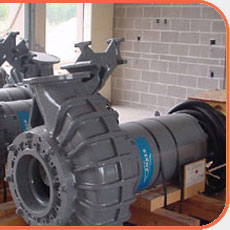The influent pump station is where wastewater from the city’s collection system (influent) enters the processing plant and is pumped to the beginning of the treatment process.

Multiple pumps such as this one, still crated, were installed at the influent pump station
One of the first steps to consider in designing the city’s new Water Reclamation Plant (WRP) was how and where wastewater would enter the plant. Factors to consider include the topography of the treatment plant site, whether gravity can be used to move water both through the city and within the plant, what kind of pumping might be required, and future growth needs in the city.
When you can let wastewater flow downhill, you are allowing gravity to do the moving. Since water won’t flow uphill, pumps must be used when the water must be moved to a higher elevation. Gravity is free; pump stations not only cost money to build, they require regular maintenance and repair. The more you can allow gravity to move the water, the fewer pump stations are needed.
The uneven elevations in the City of Mason require that some pump stations be used. Wastewater pipes throughout the city use gravity to direct the water to one of several pump stations. At the station, the water is pumped to a higher elevation, where it can again begin flowing by gravity. Some pump stations are 30 or more feet deep.
All wastewater coming into the city’s new WRP will flow into an in-plant pump station to lift it to a higher elevation so that it can flow through the remainder of the plant by gravity. The topography of the new treatment plant site and the current and future influent sanitary sewer depth dictated the location and depth of the in-plant pumping facility. By deepening the in-plant pump station to 40 feet, a large separate remote pump station to handle flows from future growth areas on US 42 can be eliminated. It is estimated that this small change when the plant was built will save $3 million in the future.
The in-plant pump station moves wastewater from the lower intake elevation to a higher elevation at the other end of the plant. From there, the liquid can flow by gravity through the rest of the plant. The key components of the new pump station include two wet wells, six submersible pumps, piping with associated valves, power supply, equipment controls, and an alarm system. The new pump station is capable of pumping a peak flow of 26 millions gallons per day.
The six submersible pumps vary in size to conserve energy during low flows. The smaller pumps, with flow rates of 1,500 to 3,000 gallons per minute (gpm), will automatically come on during low flows. The larger pumps, with flow rates up to 7,000 gpm, will be automatically activated when flows reach a designated higher flow. The pumps are designed to run alternately in an effort to keep wear and tear even and to keep all of the parts lubricated. For safety and efficiency, the pump station was designed and built to allow city maintenance staff to raise the pumps to perform routine maintenance and repairs without entering the wet wells.
The influent sewer line coming into the plant is 54 inches in diameter. The force main leaving the pump station is 36 inches in diameter and conveys the wastewater to the screening and grit removal building.
